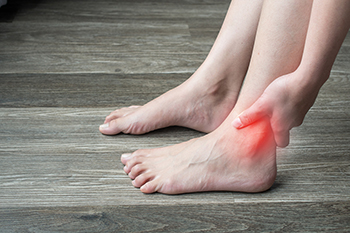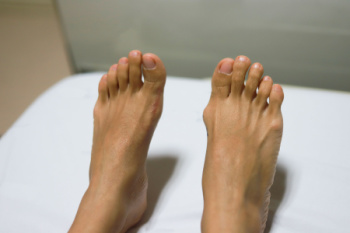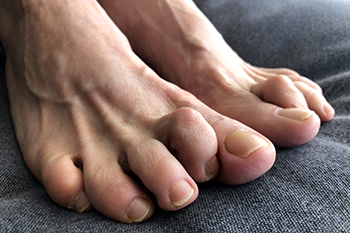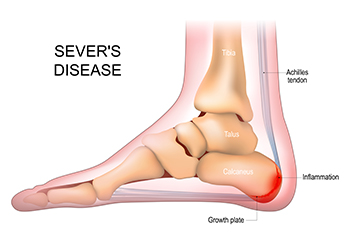Connect With Us
Blog
Items filtered by date: February 2024
Types and Causes of Ankle Impingement

A sign of ankle impingement is the appearance of bony growths that restrict normal range of motion. There are two types of ankle impingement, anterior and posterior. Anterior impingement often follows ankle sprains, resulting in persistent pain at the front or sides of the ankle, weakness, and discomfort during dorsiflexion. With posterior impingement, more common among ballet dancers, the pain is at the back of the ankle and often occurs when pointing the toes or tiptoeing. Impingement syndrome arises when tissues become trapped between bones during extreme ankle movements. Ligament thickening and scar tissue formation can worsen the condition. In severe cases of ankle impingement, surgical intervention may be necessary. If you experience intense pain when either flexing or pointing your feet, it is suggested that you make an appointment with a podiatrist to determine whether you have an ankle impingement.
Ankle pain can be caused by a number of problems and may be potentially serious. If you have ankle pain, consult with David A. Edmonds, DPM from Advanced Podiatry Associates. Our doctor will assess your condition and provide you with quality foot and ankle treatment.
Ankle pain is any condition that causes pain in the ankle. Due to the fact that the ankle consists of tendons, muscles, bones, and ligaments, ankle pain can come from a number of different conditions.
Causes
The most common causes of ankle pain include:
- Types of arthritis (rheumatoid, osteoarthritis, and gout)
- Ankle sprains
- Broken ankles
- Achilles tendinitis
- Achilles tendon rupture
- Stress fractures
- Bursitis
- Tarsal tunnel syndrome
- Plantar fasciitis
Symptoms
Symptoms of ankle injury vary based upon the condition. Pain may include general pain and discomfort, swelling, aching, redness, bruising, burning or stabbing sensations, and/or loss of sensation.
Diagnosis
Due to the wide variety of potential causes of ankle pain, podiatrists will utilize a number of different methods to properly diagnose ankle pain. This can include asking for personal and family medical histories and of any recent injuries. Further diagnosis may include sensation tests, a physical examination, and potentially x-rays or other imaging tests.
Treatment
Just as the range of causes varies widely, so do treatments. Some more common treatments are rest, ice packs, keeping pressure off the foot, orthotics and braces, medication for inflammation and pain, and surgery.
If you have any questions, please feel free to contact our offices located in Northampton and Allentown, PA . We offer the newest diagnostic and treatment technologies for all your foot care needs.
Definition and Facts About Bunions

Bunions, a foot deformity that impacts mobility and causes discomfort, afflicts millions of people across the globe. These bony protrusions form at the base of the big toe, gradually pushing it outward while forcing the tip to move toward the other toes. Despite common misconceptions, bunions are not solely caused by wearing ill-fitting shoes. Rather, they often stem from inherited structural issues, such as foot mechanics or arthritis. Bunions tend to worsen over time, leading to swelling, redness, and pain, especially when wearing tight or narrow footwear. Bunions can hinder daily activities and contribute to other foot ailments, like corns and calluses. While conservative measures, such as wearing wider shoes, using toe spacers, and applying ice packs can provide temporary relief, surgical intervention may be necessary for severe cases to realign the toe joint and alleviate discomfort. If you have developed a bony protrusion at the base of your big toe, it is strongly suggested that you consult a podiatrist who can confirm a bunion diagnosis, and offer relief and treatment options.
If you are suffering from bunions, contact David A. Edmonds, DPM of Advanced Podiatry Associates. Our doctor can provide the care you need to keep you pain-free and on your feet.
What Is a Bunion?
A bunion is formed of swollen tissue or an enlargement of boney growth, usually located at the base joint of the toe that connects to the foot. The swelling occurs due to the bones in the big toe shifting inward, which impacts the other toes of the foot. This causes the area around the base of the big toe to become inflamed and painful.
Why Do Bunions Form?
Genetics – Susceptibility to bunions are often hereditary
Stress on the feet – Poorly fitted and uncomfortable footwear that places stress on feet, such as heels, can worsen existing bunions
How Are Bunions Diagnosed?
Doctors often perform two tests – blood tests and x-rays – when trying to diagnose bunions, especially in the early stages of development. Blood tests help determine if the foot pain is being caused by something else, such as arthritis, while x-rays provide a clear picture of your bone structure to your doctor.
How Are Bunions Treated?
- Refrain from wearing heels or similar shoes that cause discomfort
- Select wider shoes that can provide more comfort and reduce pain
- Anti-inflammatory and pain management drugs
- Orthotics or foot inserts
- Surgery
If you have any questions, please feel free to contact our offices located in Northampton and Allentown, PA . We offer the newest diagnostic and treatment technologies for all your foot care needs.
Do Your Child's Feet Hurt?
Surgical Options for Hammertoe

Hammertoe, a deformity characterized by curled or flexed toes, may necessitate surgical intervention when conservative treatments fail to provide relief. Surgical hammertoe options include bone resection to remove portions of toe bones, tendon procedures involving manipulation or transplantation to correct the imbalance, and joint fusion to stabilize the toe. Following surgery, pins or wires may be used temporarily to maintain alignment during healing, with patients transitioning to supportive footwear to aid recovery. Surgical considerations are driven by functional impairment and pain, with persistent symptoms such as pain, irritation, and skin complications warranting consideration for intervention. However, surgery may not be recommended if conservative measures suffice or if the risks outweigh the benefits. It is important to explore all treatment plans before deciding on whether to have surgery. For this reason, if you have a hammertoe that is impeding your daily activities, it is suggested that you schedule an appointment with a podiatrist.
Hammertoe
Hammertoes can be a painful condition to live with. For more information, contact David A. Edmonds, DPM from Advanced Podiatry Associates. Our doctor will answer any of your foot- and ankle-related questions.
Hammertoe is a foot deformity that affects the joints of the second, third, fourth, or fifth toes of your feet. It is a painful foot condition in which these toes curl and arch up, which can often lead to pain when wearing footwear.
Symptoms
- Pain in the affected toes
- Development of corns or calluses due to friction
- Inflammation
- Redness
- Contracture of the toes
Causes
Genetics – People who are genetically predisposed to hammertoe are often more susceptible
Arthritis – Because arthritis affects the joints in your toes, further deformities stemming from arthritis can occur
Trauma – Direct trauma to the toes could potentially lead to hammertoe
Ill-fitting shoes – Undue pressure on the front of the toes from ill-fitting shoes can potentially lead to the development of hammertoe
Treatment
Orthotics – Custom made inserts can be used to help relieve pressure placed on the toes and therefore relieve some of the pain associated with it
Medications – Oral medications such as anti-inflammatories or NSAIDs could be used to treat the pain and inflammation hammertoes causes. Injections of corticosteroids are also sometimes used
Surgery – In more severe cases where the hammertoes have become more rigid, foot surgery is a potential option
If you have any questions please contact our offices located in Northampton and Allentown, PA . We offer the newest diagnostic and treatment technologies for all your foot and ankle needs.
Definition and Symptoms of Sever’s Disease

Sever's disease, despite its name, is not an illness, but a common heel bone disorder that affects children during their growth spurts. Also known as calcaneal apophysitis, this condition occurs when the heel's growth plate experiences inflammation due to repetitive stress and tension. Typically afflicting children aged 8 to 14, Sever's disease emerges as the bones grow faster than the tendons, leading to strain on the heel's growth plate. Young athletes engaged in high-impact sports, such as soccer, basketball, and gymnastics, are particularly susceptible. The symptoms can include heel pain, swelling, and discomfort, which can be worse during physical activities. Recognizing Sever's disease is important, as prompt intervention can alleviate symptoms and prevent long-term complications. If your child has heel pain, and frequently participates in sporting activities, it is suggested that you consult a podiatrist who can accurately diagnose and treat this condition.
Sever's disease often occurs in children and teens. If your child is experiencing foot or ankle pain, see David A. Edmonds, DPM from Advanced Podiatry Associates. Our doctor can treat your child’s foot and ankle needs.
Sever’s Disease
Sever’s disease is also known as calcaneal apophysitis, which is a medical condition that causes heel pain I none or both feet. The disease is known to affect children between the ages of 8 and 14.
Sever’s disease occurs when part of the child’s heel known as the growth plate (calcaneal epiphysis) is attached to the Achilles tendon. This area can suffer injury when the muscles and tendons of the growing foot do not keep pace with bone growth. Therefore, the constant pain which one experiences at the back of the heel will make the child unable to put any weight on the heel. The child is then forced to walk on their toes.
Symptoms
Acute pain – Pain associated with Sever’s disease is usually felt in the heel when the child engages in physical activity such as walking, jumping and or running.
Highly active – Children who are very active are among the most susceptible in experiencing Sever’s disease, because of the stress and tension placed on their feet.
If you have any questions, please feel free to contact our offices located in Northampton and Allentown, PA . We offer the newest diagnostic and treatment technologies for all your foot and ankle injuries.

